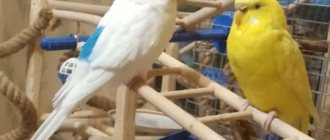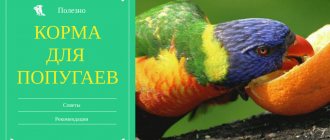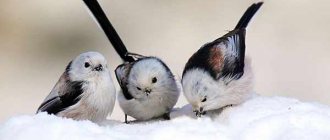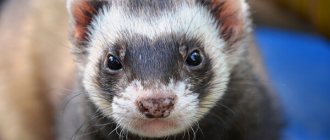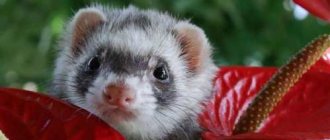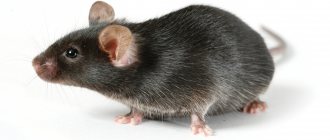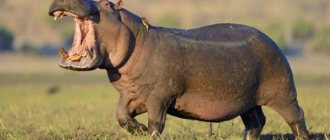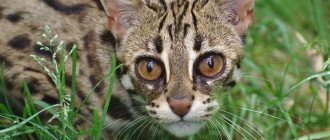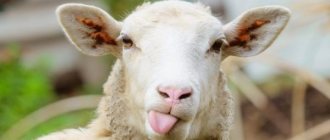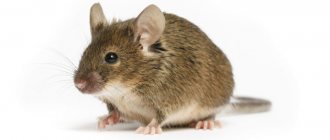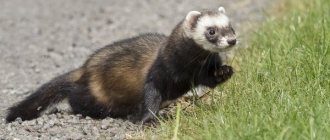Today parrots can be found in all corners of our planet. They say that Australia is the “father’s home” for all species, although these birds are common on all continents, not counting Antarctica and Europe. Traveling through South and Central America, India, Southeast Asia, West Africa and Australia, you have the opportunity to see how incredibly beautiful and intelligent parrots can be. But, of course, in order to admire birds in their natural habitat, you don’t have to pack your bags - thanks to technological progress, every person has the opportunity to plunge into the world of parrots.
Parrots prefer to live in subtropical and tropical climates, so the Southern Hemisphere is the optimal region for the life of these birds:
As the map transitions from lighter to darker shades, we can conclude that the greatest diversity of parrot species is found in South America and Australia:
More than 370 species of these stunning birds live around the world.
Where parrots live according to their families can be clearly shown by a world map with indicators of specific bird species:
Basically, parrots live in flocks and groups; by their nature, they are monogamous birds, which, when favorable conditions arise, unite in pairs, create housing using the hollows of eucalyptus trees, digging holes or inhabiting rock crevices. Birds manage to raise a new generation of parrots as soon as the weather allows them to engage in carefree mating games and adequate nutrition for the whole family.
Amazon
Amazons live in South America in the forests of the Amazon River basin; also some species of this genus are found in Central America and the Antilles. These parrots prefer to live in regions with tropical and subtropical climates. Amazons gather in packs or small family groups and stay mainly in dense forest thickets; green plumage makes them invisible against the background of foliage. The most comfortable conditions for these birds are increased humidity and air temperature. In addition to forests, Amazons can be found in savannas and mangroves. These parrots are also sometimes observed in cultural landscapes.
Lovebirds
The homeland of lovebirds is Africa. Also, some species of this genus can be found on Madagascar and other islands located near the African continent. Different types of lovebirds prefer to settle in different biotopes: subtropical and tropical forests, mountains or steppes. Birds like to stay near bodies of water; sometimes they can be seen near human habitation. Lovebirds lead a gregarious lifestyle. At night, flocks of parrots rest in trees, sitting on branches, and during the day they go in search of food. Lovebirds nest in tree hollows. At the bottom of the hollow, the female builds a nest from grass, twigs and pieces of bark.
Budgerigar
The budgerigar lives in Australia. Among Australian parrots, this species is the most common. Budgerigars can be found throughout the continent, with the exception of dense northern forests, and also on some nearby islands (for example, Tasmania). Birds unite in flocks numbering up to several hundred individuals. In search of food and water, they roam all over the continent. Budgerigars prefer to stay in semi-deserts, steppes and grassy plains, avoiding areas with a lot of trees. They can be found inland and on the coast.
Natural enemies
Natural enemies of parrots are represented by large feathered predators, as well as many terrestrial predatory animals. The meat of some species of parrots, especially cockatoos and Amazons, is actively used as food by the indigenous Indians inhabiting the territory of South America, as well as by Australian aborigines.
According to the testimony of travelers and scientists, some Indian tribes of the Amazon have long raised macaws. Birds raised in this way are not killed for meat, but are used exclusively for periodically plucking colorful, bright feathers necessary for making ceremonial headdresses.
Return to content
Cockatoo
Cockatoos inhabit Australia, New Guinea, the Solomon Islands, the Bismarck Archipelago and the eastern part of the Malay Archipelago. The cockatoo family includes 21 species. Of these, 11 species are endemic to Australia, 3 are found in Australia and New Guinea, and 7 live outside the Australian continent. Several species have been accidentally introduced outside their native range and are found in New Zealand, Singapore, the Moluccas and Palau, and Puerto Rico. These parrots live in the wild in almost all landscapes and live in flocks of several dozen individuals. Some species lead a nomadic lifestyle.
Jaco
Grays live in West Africa. They are found in Angola, Guinea, Congo, Liberia, and Sierra Leone. The range of the Gray Gray coincides with the area of distribution of the oil palm, the fruits of which these birds feed on. These parrots are naturally found in areas covered with dense forests. They can be found in mangroves. Grays have difficulty moving on the ground, so they do not like open spaces and prefer to stay in forest thickets. Birds gather in groups of several dozen individuals. They spend the night on tall trees with dense crowns, and in the morning they go in search of food.
Types of parrots
Today in Russia, the passion for parrots has reached its peak. Several dozen species are bred, including wavy ones, lovebirds, lorises, rosellas, etc. Talking ones, such as grays, amazons, cockatoos and macaws, are especially popular.
Below are photographs and descriptions of the most famous species of parrots in our country.
Macaw
The macaw is the largest and most colorful of all existing parrots. Its height reaches up to 95 centimeters, although it weighs only about one and a half kilograms. This is explained by the fact that it has very voluminous plumage, which weighs almost nothing, and its body is no larger than that of an ordinary chicken. The tail is almost twice as long as the body. The Macaw's homeland is South and Central America, where they still live in natural conditions. The macaw is one of the most capable species; with proper training, it can master several dozen words and phrases in a year. Keeping him at home is not particularly difficult; the main requirement is a large cage so that he can feel free, or even better, an enclosure so that he can at least sometimes use his flying abilities.
Luxurious barrabandov
Luxurious barrabandov - originally from Australia. Medium sized bird. It can be up to 40 cm in length, half of which is the tail. It has bright green plumage and a yellow forehead, chin and throat. There is a transverse red stripe on the throat. Thanks to its green color, it can perfectly camouflage itself in the foliage of trees. The ability to reproduce human speech has become the reason for its great popularity among lovers of indoor birds.
Cockatoo
Cockatoo is one of the most beautiful, intelligent and charming parrots. He comes from Australia, lives in Indonesia, New Guinea, and the Philippine Islands. This is the same parrot of the pirate Flint from “Treasure Island”, which of course everyone saw in the movies and probably remembered him: “Piastres, piastres!!!”. This is a fairly large bird, up to 60 cm in size and weighing 600 grams. It has several varieties, the most famous of which are: yellow-crested, Moluccan, pink, white-crested, Inca, Tanimbar, corella, etc. The cockatoo has high intelligence, quickly learns to speak and easily adapts to people.
Jaco
The Gray is a medium-sized bird, about half a meter long with a tail, gray and discreet in color. Jaco's homeland is Africa, where he lives in tropical forests and mango thickets along river banks. Despite its unassuming appearance, the Gray is considered the most capable and easily trained speaking parrot. This child prodigy is able to learn several new words and even phrases in a short time and reproduce them very clearly, while respecting the intonation he heard. This gray talker is able to quickly, often the first time, repeat a word or phrase he hears. He usually inserts himself into people's conversations, inserting his sayings often at the right time and place. Due to the high demand for Grays, they were caught in huge numbers, resulting in Grays becoming a rare species.
Laurie
Lori is a whole family of parrots, more than 60 species. The birds are small in size, depending on the species, they can be 20 to 40 cm in length. They are very brightly colored, which is why they were given this name. Laurie means clown in Dutch. The homeland of these beauties is Australia, New Guinea, New Caledonia, the Sunda and Moluccas Islands. Lorises are smart and capable birds. They perfectly imitate the sounds they hear, especially the voices of other birds, although their own voice is rather harsh and creaky. They learn quickly and can memorize several dozen words. Keeping loris in the house is associated with certain difficulties. They prefer liquid food and are very messy. To avoid an unpleasant odor, you have to clean the cage daily. But they are very friendly and sociable.
Senegalese
The Senegalese is a parrot from Africa. Lives in forests of Senegal, Cameroon, Nigeria, Chad. The birds are small in size, just over 20 cm long and weighing up to 150 grams. The green plumage of the body with reddish sides, the gray head and black beak give the Senegal a rather elegant, spectacular appearance. There are three species, differing mainly in color. This is an interesting and funny bird, capable of learning a couple of dozen words in a short time. His pronunciation is not entirely clear, but he is able to copy the intonation of what he hears.
Amazon
Amazon is a bird whose habitats are clear from its name: the humid tropics of South and Central America and the islands of the Caribbean Sea. They can be up to half a meter in size, the plumage is mostly green, some have red spots on the head, wings or tail. Amazons have exceptional imitative abilities. They easily copy the voices of birds and animals, the sounds of musical instruments, the voices and exclamations of people. They remember several dozen words and several phrases and are easy to train. Calm, sociable, happy to demonstrate their abilities. There are 26 species, the most popular being the Cuban Amazon. One of the most expensive birds.
Kakarik
Kakarik or New Zealander is a native of New Zealand and several islands of the South Pacific Ocean. Kakarik means "little parrot" in the Maori language. These are really small birds, up to 25 cm in size and weighing up to 100 grams. Only four species have survived in nature, differing in color: red-fronted, yellow-fronted, mountain jumping, Antipodean jumping. Yellow is also found, but only among those bred in captivity. Very active and cute beautiful birds to keep at home.
Greater Alexandrian
Greater Alexandrian is a bird up to 50 cm in size and weighing about 300 grams. It has 5 subspecies, differing in size and color. Lives in Asian countries: India, Pakistan, Vietnam, Laos, Nepal, Burma. Males have a peculiar necklace on their necks, black on the front and pink on the back. The beak of this parrot is bright red. It has a rather aggressive character, but with patience it can learn a dozen words and phrases. Can imitate various sounds well.
Royal
The Royal is a very elegant red bird with green wings and back. It grows to a size of 40 cm. Under natural conditions, it lives in forests, gardens and eucalyptus groves in south-eastern Australia. They easily learn to speak, remember a dozen and a half words and phrases. They cannot imitate songbirds, but they are very trainable and can perform various tricks, including spinning on a crossbar.
Congolese
Congolese, a rare bird from Africa. In size it can be no more than 30 cm in size. The color of the plumage is mostly green, the back and wings are dark with black trim. There is a red spot on the forehead. The eyes are orange and sometimes brown. Character: calm, flexible. An excellent simulator of sounds, especially whistling. Very capable of learning and with a good memory.
Monk
The monk or quaker is a small parrot, about 30 cm in size, native to South America. The plumage is green, the chest is pale greenish, and the beak is straw-colored. The forehead and cheeks are gray, like the robes of monks, which is why they got their name. They live in Brazil, Argentina, Bolivia, Uruguay, Paraguay. They settle in trees, making nests in the branches. They live in colonies of 300–500 individuals. Monks are very friendly and sociable birds. Easy to learn to talk. They have a good memory, remembering up to one and a half dozen words and sentences.
Rosella
Rosella is a small parrot, up to 30 cm long. It lives in nature in Australia and nearby islands. There are several species with different colors: red, green, motley, yellow-cheeked, pale-headed, black-headed, collared. Their cheeks are blue, yellow or white, depending on the species. They live in small flocks of up to 50 pieces. in forests, parks and groves. They often raid farmland. They remember a few words and phrases, but sing better, imitating many songbirds.
Lovebirds
Lovebirds are small birds, from 10 to 17 cm, weighing 40-60 g. There are 9 species: Fisher, Masked, Liliana, Black-winged, Green-headed, Orange-headed, Strawberry-headed, Black-cheeked. They differ in the color of their plumage, the predominant colors being green, red, yellow, pink, blue and brown. The homeland of lovebirds is Africa and Madagascar. The owl got its name because of its lifestyle. They mate for life and always stick together.
Wavy
Budgerigars are the most common type of parrot. Medium sized bird. Length up to 20 cm. Weight 40-45 g. The natural color of wild budgies is green, but thanks to the efforts of breeders, there are now all kinds of colors. Their homeland was originally Australia, but nowadays they are mainly bred under artificial conditions in many countries around the world. Noisy and chatty birds, they easily remember words and phrases, which they then often pronounce in communication with people or other pets or birds. Memorized words are pronounced simply like that, without any logic. An excellent choice for keeping at home.
Corella
Corella is a parrot from the cockatoo family. The bird is medium-sized, about cm long, weighs about 100 g. Initially, their plumage was dark olive, the head and crest were yellow. Nowadays there are several dozen Karella parrots bred by breeders. They differ only in different colors: White, Lutino, Light Grey, Cinnamon Colors, Dark Yellowish, Albino, Sheki, Harlequins, Pearl Grey, White Wing, Black Wing, Black. A feature of all species is a crest on the head and a long tail. Cockatiels are one of the most popular parrots to keep at home. They learn easily, pronounce words clearly, have a good memory, are sociable and good-natured.
This is not a complete list of parrots that people now keep in their houses and apartments. In any case, no matter what parrot you choose for yourself, it will initially be a pleasant surprise for your household, and over time it will become a full member of your family.
Macaw
Macaws inhabit Central and South America: Brazil, Peru, Paraguay, Bolivia, the eastern regions of Chile and Panama, as well as the Caribbean islands. These parrots are found in humid tropical forested areas and wetlands; they can be found at altitudes of up to 500 m above sea level. Flocks of macaws, numbering up to hundreds of individuals, can harm fruit plantations. Macaws prefer to stay away from humans and other bird habitats. During the mating season, they split into pairs, which remain for life, and nest in tree hollows.
Raids on farmland
While Australia remained isolated from the outside world, there were significantly more parrots there. This is not surprising - when the colonists arrived, the first thing they did was plow the lands that once provided food for birds.
The bulk of people live on the coasts. The north of Australia has an even climate, thanks to which Australians have the opportunity to grow crops all year round. That’s why parrots every now and then deign to feast on something from the fields and gardens.
In captivity, one parrot is content with two teaspoons of food per day. This is enough, because the bird spends its days in pleasure without much effort and fear of being killed by enemies. And in the wild, every day they have to fly a remarkable number of kilometers in search of food. This requires enormous energy expenditure, because constant flying and running greatly tires the bird. That’s why birds are sometimes forced to “steal” from people.
